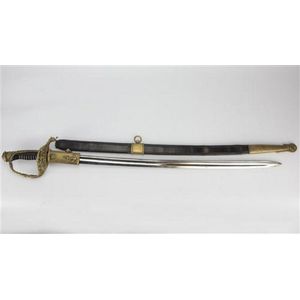Japanese Wakizashi Sword in Handachi Mounts and Lacquer Saya
You must be a subscriber, and be logged in to view price and dealer details.
Subscribe Now to view actual auction price for this item
When you subscribe, you have the option of setting the currency in which to display prices to $Au, $US, $NZ or Stg.
- Shakudo - Japanese shakudo is a traditional alloy that has been used in Japan for centuries. It is primarily composed of copper and gold, with the copper serving as the base metal and the gold adding a yellowish hue to the alloy. Shakudo is known for its beautiful dark blue-black or black colour, which is achieved through the addition of a small amount of a patina-inducing element like silver or arsenic.
The word "shakudo" itself can be translated as "red copper" in Japanese, referring to the reddish-brown color of the pure copper base metal before it is patinated. The gold content in shakudo is usually around 4-10%, but this can vary depending on the specific purpose or desired appearance.
Shakudo has been traditionally used in various forms of decorative arts and crafts in Japan. It is particularly associated with metalwork, including sword fittings (such as tsuba, menuki, and kashira), jewelry, and small ornamental objects. The alloy's dark color provides a striking contrast to other metals like silver or gold, making it ideal for intricate inlay work or as a background for other decorative elements.
This item has been included into following indexes:
Visually similar items

A fine signed Japanese Samurai sword, the fine katani with a folded steel blade, a sting ray covered and cloth bound handle, with peg, gold relief decorated menuki, fuchi and tsuba, and a signed tanto with embellished handle; signed underneath the handle g

Klingenthal Coulaux et C French naval officer's sword & scabbard featuring a stylised & decorated ornate guard spiraling into the pierced decorated guard, showing navl fouled anchor & leaf filigree design. the black Bakelite type grip retains the original

Shinshinto Wakizashi sword the blade unsigned, ubu blade, with a long kissaki. the blade is in worn old polish, showing fine scratches but no rust, no stains or flaws. the hamon is gunome pattern & has deep turn back temper at the point. the forging grain

Mont Blanc, Imperial dragon pencil, sterling silver dragon clip with ruby eyes, the black resin and rhodium plated barrel inscribed 'Imperial dragon', signed 'Mont Blanc Meisterstuck edition', numbered 0855-1500
